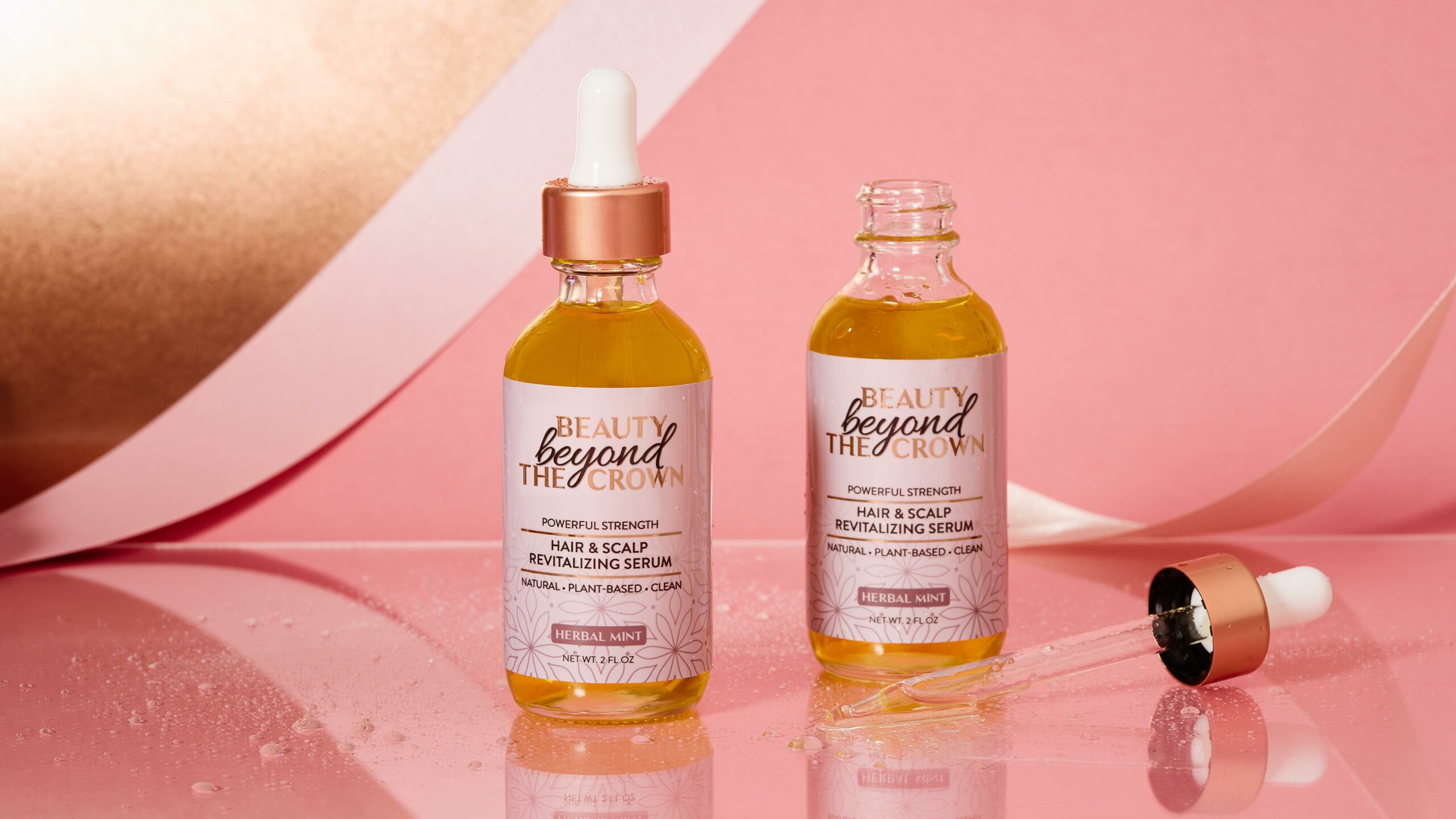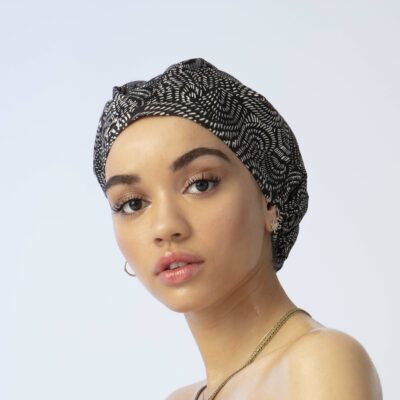
Long Before The Infamous Slap At The Oscars, Cherlyn Hayes Struggled With Alopecia. She’s Using Her Brand To Share Her Story And Help Others.
For many people, the controversy over Will Smith slapping Chris Rock at the Academy Awards last Sunday in response to a “G.I. Jane” joke referring to his wife and alopecia sufferer Jada Pinkett Smith’s shaved head is their first time learning about the hair loss condition. For Beauty Beyond the Crown founder and CEO Cherlyn Hayes, though, alopecia is an everyday topic. She’s among the roughly one-third of Black women who deal with it. For over a decade, Hayes has sorted through her feelings about alopecia and what she should do about her hair loss. She’s tried around 20 treatments, from hair transplant surgery to steroid ointment. Some have been effective. Some haven’t been effective.
In 2020, Hayes started her brand to offer Hair & Scalp Revitalizing Serum as a botanical option for people with alopecia, but, more generally, her objective is to be a sounding board for and comfort to women with hair loss, no matter their approach to it. “I want to be that voice for women to be able to come forward and not be afraid to talk about it,” says Hayes. “If we can share our stories with each other, maybe we can help the next person and the next person after that.” Beauty Independent talked to her about the infamous slap and her alopecia experience to shed light on a condition often kept in the dark, at least before the Oscars. Below, Hayes shares her story.
I was shocked just like everyone else about what happened as far as Will going up on stage and his action, but I think that it definitely brought awareness to alopecia. It’s a trending topic and a great opportunity for people to educate themselves on it. As far as how it happened, I definitely don’t condone violence in any way, but I feel like they can hopefully work it out. They are adults. As far as alopecia goes, it’s a sensitive topic depending on what the person is like and how they take what is said. I may have thicker skin than someone else.
My alopecia is a twofold situation. It’s something that’s hereditary in my family, and it’s activated if a medical condition is present. I was predisposed to it, but I never thought I would experience it. My first experience happened around 2008 when I was 28 and changed my birth control. I was also in a very stressful relationship. What I saw was my hair was literally falling out from the roots. It was so sparse. I couldn’t figure out anything I had done differently other than change my medication. I was shocked and devastated. I decided to camouflage it. I was wearing hair extensions at the time.
I thought that, maybe if I go back on the previous birth control, the symptoms would reverse themselves, but that didn’t happen. My mother said, “Hey, you need to go to the doctor, and get some blood work done. Maybe you have an endocrine issue.” I did, and they found things that were abnormal. I have Hashimoto’s, a thyroid condition. My body is attacking my thyroid. I was prescribed medication, and the symptoms with my hair were on and off. It was cyclical. I would still experience hair loss.

At that point, my main concern was the very front of my hair around the perimeter, where I had traction alopecia. That’s where there’s trauma to the root of the hair from ponytails, braids or hair extensions. I wanted to address that, but I couldn’t find the right doctor to help me address it. I got on Rogaine. If you discontinue using Rogaine, your hair stops growing. I didn’t want to continue on that path for a long period of time. In 2017, a dermatologist performed a biopsy to my scalp, and I got a hair transplant in 2018 that was successful, although I know I have to get another one.
I didn’t realize I was having another issue at the top of my head. I was like, “Oh my gosh, I addressed the issue in the front, and now I’m having another one.” I had decided to reach out to a different dermatologist at Johns Hopkins Dermatology, and it was determined I had Central Centrifugal Cicatricial Alopecia (CCCA) and Androgenic Alopecia. CCCA is a scarring alopecia caused by inflammation in the body. It diminishes your hair follicles and causes a layer of scarring where your hair doesn’t grow anymore. Androgenic Alopecia is female-pattern baldness. With that, I said, “I really want to do something about this.” I didn’t want to continue living like I was. I needed more answers. With Black African American women, there’s little study done on it, but, typically, it’s found in Black African American women.
It was hard. I had feelings of depression, hopelessness and of being judged, but no one really knew what I was going through except for close friends and family. I camouflaged it with wigs. I still wear wigs now, and sometimes I wear head scarfs and head wraps. Society places judgment on women and how we appear all the time. As women, we pride ourselves on our hair and can be sensitive about it. I was definitely feeling sad, but I did find a way to get through it with wigs I could wear to fit my look. I like to change it up, and that’s the fun thing about wigs. Sometimes, it’s a dark wig with highlights. Sometimes, it’s a blonde wig. It depends on the mood I’m in.
“I want to be the voice for women to be able to be brave and stand in their own truth.”
With dermatologists, the main recommendation to me was to use Rogaine. I’ve tried steroid injections, and they didn’t necessarily work for me, but they can for someone else. I’ve also tried a topical steroid that I’m currently still using, and there’s another ointment mixed with minoxidil in addition to the Hair & Scalp Revitalizing Serum. I’m using all three right now and seeing some progress. I have gone through PRP treatments or platelet-rich plasma treatments. That’s where they withdraw your blood, separate the plasma from it and inject it into your scalp. I’ve had three sessions and have another one approaching.
Insurance unfortunately doesn’t cover a lot of this. They don’t cover the PRP treatments. I don’t understand why not. They don’t typically cover hair transplant surgeries either, but, if you can prove it’s tied to something medical, they may cover it. For the ointments prescribed by a dermatologist, it really depends. It’s very, very expensive, and a lot of women aren’t able to have these treatments because they just can’t afford them. I’ve spent thousands and thousands, from the hair transplant to the PRP treatments to the ointments.
There are many positives in what science offers, but I wanted to go in more of a clean, natural route with my brand. I don’t think the beauty industry addresses alopecia enough. There are many women coming forward speaking about their journey with alopecia. They may have either experienced it postpartum or because of chemotherapy. I don’t think there’s enough education around it, and I want my business to help people understand it.

I have had people reach out to me saying, “I didn’t know you were dealing with this.” From the outside, they thought I was perfect, but everyone is going through something. This is my journey, and you can still have a very fruitful life even though you are dealing with something like this. For the future of my brand, I want products that will address alopecia and hair loss. I want my story to resonate with people and help them take action. I want to have a platform to talk about stress. Stress management is a huge thing when it comes to alopecia. I want to talk about mental health and nutrition, and how they play a part, and even how hair practices play a part.
I want to be the voice for women to be able to be brave and stand in their own truth to say, “OK, if I have a bald head, that’s OK. If I decide to wear a head wrap, that’s OK, and if I decide to wear a head scarf, that’s OK, and I shouldn’t be judged for going that route.” People should be kind to one another and be careful with comments because you never know what someone may be battling.
Feature photo credit: Phelan Marc





Leave a Reply
You must be logged in to post a comment.